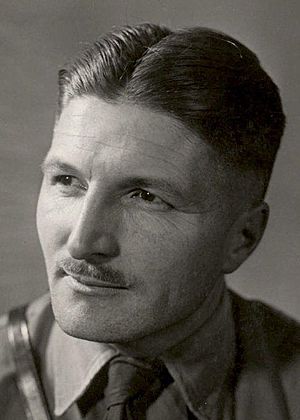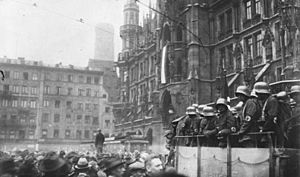Joseph Berchtold facts for kids
Quick facts for kids
Joseph Berchtold
|
|
|---|---|

Berchtold in his SA uniform
|
|
| 2nd Reichsführer-SS | |
| In office 15 April 1926 – 1 March 1927 |
|
| Leader | Adolf Hitler |
| Preceded by | Julius Schreck |
| Succeeded by | Erhard Heiden |
| Personal details | |
| Born | 6 March 1897 Ingolstadt, Kingdom of Bavaria, German Empire |
| Died | 23 August 1962 (aged 65) Herrsching, Bavaria, West Germany |
| Political party | National Socialist German Workers' Party (Nazi Party; NSDAP) |
| Military service | |
| Allegiance | German Empire |
| Branch/service | Army |
| Battles/wars | World War I |
Joseph Berchtold (born March 6, 1897 – died August 23, 1962) was an important early member of the Nazi Party. He helped start two groups within the party: the Sturmabteilung (SA) and the Schutzstaffel (SS).
Berchtold fought in World War I. After Germany lost the war, he joined a small political group called the German Workers' Party (DAP). This group later became known as the National Socialist German Workers' Party, or Nazi Party. Joseph Berchtold became the second leader of the Schutzstaffel (SS). He held this role from April 1926 to March 1927.
After leaving his role as SS leader, Berchtold spent a lot of time writing for Nazi newspapers and magazines. He survived World War II and was arrested by the Allies. Berchtold was later set free and passed away in 1962. He was the last person to have held the rank of Reichsführer-SS and the only one to survive the Second World War.
Contents
Early Life and Joining the Nazi Party
Joseph Berchtold was born on March 6, 1897, in Ingolstadt, Germany. He went to school in Munich from 1903 to 1915. He then joined the Royal Bavarian Army and fought in World War I (1914-1918). By the end of the war, he was a second lieutenant.
After the war, he studied economics at the University of Munich. He then started working as a journalist. In early 1920, he joined the German Workers' Party (DAP). He stayed with the party when it changed its name to the National Socialist German Workers' Party (Nazi Party). Berchtold became the treasurer for the Nazi Party. He left this role in July 1921.
Involvement with the SA

Berchtold rejoined the Nazi Party in 1922. He became a member of the Sturmabteilung ("Storm Detachment"), also known as the SA. This was a special group within the party. Its job was to protect Nazi speakers at events and keep order at their meetings.
In 1923, Adolf Hitler, who was the leader of the Nazi Party, wanted a smaller, special bodyguard group just for himself. This group was first called the Stabswache ("Staff Guard"). It had only eight men, led by Julius Schreck and Berchtold. Later that year, the group was renamed Stoßtrupp-Hitler ("Shock Troop-Hitler").
On November 9, 1923, the Stoßtrupp, along with the SA and other groups, took part in an event called the Beer Hall Putsch. The plan was to take control of Munich and then gain power across Germany. However, the attempt failed. Sixteen Nazi supporters and four police officers died. After this event, Hitler and other Nazi leaders were put in prison. The Nazi Party and its groups were officially shut down. Berchtold left Germany and went to Tirol, Austria.
Berchtold was later tried in court in Munich for his part in the Beer Hall Putsch. He was sentenced to prison, even though he was not there. While in Austria, Berchtold continued to be involved with the Nazi Party, even though it was illegal.
When Hitler was released from prison in December 1924, Berchtold was leading the Nazi Party and the SA in Carinthia, Austria. The Nazi Party was officially reformed in February 1925. Berchtold rejoined the party in March 1926 and returned to Munich. He then became the chief of the SA in Munich.
Leading the SS
On April 15, 1926, Joseph Berchtold took over from Julius Schreck as the leader of the Schutzstaffel ("Protection Squadron"), or SS. The SS was a special, elite part of the Nazi Party. It was under the control of the SA at this time.
Berchtold changed the name of his leadership position to Reichsführer-SS. He created new rules for the SS. These rules said the SS was not a military group. Instead, it was a small team of men that the Nazi movement and Hitler could trust. He also said that the men must follow "only party discipline." Berchtold wanted the SS to be more independent. However, he found it hard to stop the SA from having authority over the SS. Because of this, he became frustrated. On March 1, 1927, he gave up his leadership of the SS to his deputy, Erhard Heiden.
Life After Leading the SS
In 1927, Berchtold became a main writer for Völkischer Beobachter, which was the Nazi Party's newspaper. From 1928 to 1945, he was an SA leader on the staff of the Supreme SA leadership (OSAF). In 1934, he became the permanent deputy editor-in-chief of the Völkischer Beobachter newspaper. In the years that followed, he mostly worked as a journalist and helped spread Nazi ideas.
In 1928, Berchtold started a newspaper called SA-Mann ("SA Man"). He was the main writer for this paper until January 1938. He also wrote for other Nazi publications and magazines.
Berchtold held other positions in Nazi Germany, but these were less important to him. From March 1934 until the end of the war, he was a city councilman in Munich. On November 15, 1935, Berchtold was named the Reich Culture Senator. He also joined the "Cultural Circle of the SA" in March 1936 and was part of the Reichstag from March 1936 onwards. From April 29, 1940, Berchtold served as a temporary captain in the reserve of the Wehrmacht (German armed forces).
After World War II
After World War II ended in Europe, Berchtold was arrested in 1945. He was held in Oberpfaffenhofen. He passed away on August 23, 1962, in Herrsching am Ammersee, which is near Munich.
Images for kids
See also
 In Spanish: Joseph Berchtold para niños
In Spanish: Joseph Berchtold para niños


